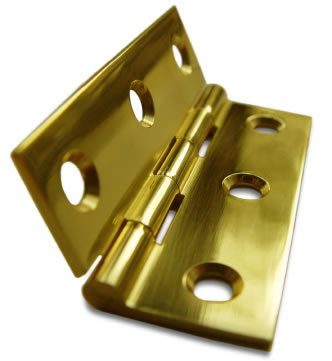How do you know which hinge is the right one for your project?
The array of hinges found in a local hardware store can be dizzying. First and foremost, you may be able to narrow down the selection by some major factors. Based on the size, weight, and shape of your work materials, does the hinge need to be small and delicate or heavy and durable?
Another factor to consider is that, while most hinges are reversible (either end can be mounted in the upright position); some are made for either a right- or left-hand door. One example of this is the loose-pin hinge. With this hinge, common for hanging doors, the pin must be removed from the top; therefore, you cannot reverse a loose-pin hinge. You can tell if you need a right- or left-hand hinge by standing on the outside of the door. If the door opens from you toward your right-hand side, you need right-hand hinges. If it opens from you toward your left-hand side, you need to stock up on left-hand hinges.
 Also think about how much of the hinge you would like to be showing when the door is closed. If the hinge is showing, should it be decorative in nature or can it be simple and functional in design? If you would prefer most of the hinge to be concealed, will this affect the functionality and ease of use in any way?
Also think about how much of the hinge you would like to be showing when the door is closed. If the hinge is showing, should it be decorative in nature or can it be simple and functional in design? If you would prefer most of the hinge to be concealed, will this affect the functionality and ease of use in any way?
Below is an alphabetical list of some of the most popular hinges and their common uses. If you have any questions, speak with a salesperson when you go to purchase the hinges. And happy hinging!
A version of the butt hinge, the back flap hinge is smaller and mostly used for furniture.
The main advantage of a ball bearing hinge is its status as permanently lubricated. They are a more expensive hinge and are typically used for heavy-duty door mountings, such as doors opening to a building’s exterior. They can also be useful for any doors that see excessive use.
Butt hinges are usually between 13 and 150mm in size. They come in two varieties: rigid pin (pin cannot be removed) and loose pin (pin can easily be tapped out with a screwdriver). They are used for mounting regular doors and cabinet doors. The rising butt hinge is designed for use on doors that rest on shag carpeting.
The benefits of the butterfly hinge, used on light-weight doors, lay in the variety of shapes and patterns available and their ease to fit.
The double acting hinge opens in either direction and is used mostly for folding doors.
The flush hinge is not as strong as a butt hinge, and is used mostly as a cabinet hinge. The flush hinge is recommended for use on light doors and in situations where you would prefer to conceal the entire hinge except the barrel.
Knuckle hinges are loose joint hinges that are decorative in nature. Although they can hold a significant amount of weight, their design ensures that a closed door shows only the knuckle of the hinge. Knuckle hinges are recommended for door mountings.
Offset blind hinges are designed to allow a full opening and swing-away such as that typically found on screen or storm doors.
Parliament hinges are recommended when the hinge pin must project beyond the door face.
The pivot hinge is versatile, being used for recessed doors, overlay doors, or flush doors. A benefit of the pivot hinge is that it doesn’t need a door frame for mounting.
As the name indicates, the spring loaded hinge contains a spring-loaded mechanism to automatically close the door. Models with adjustable tension features are available.
Table top hinges are recommended for situations where one leaf in a section of wood must be dropped.
Concealed hinges typically come in sizes of 25mm and 36mm. The concealed hinge’s benefits include being adjustable once fitted. It was designed for use with chipboard and MDF.
Specialty hinges include strap hinges, T hinges, and continuous hinges. Strap and T hinges are available in several sizes and are recommended for heavy installation situations. The continuous hinge, on the other hand, is used mostly on chest lids, cabinets or where a long hinge is necessary. Also called a piano hinge, the continuous hinge comes in brass or steel and in many sizes.